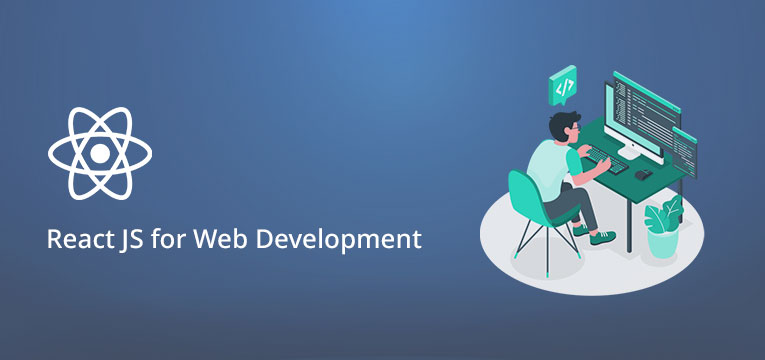There is a lot of cutthroat competition going around especially in the business realm! Developing an enterprise application in the swiftest and secured way is...
ReactJS for Web Development – Why & Where To Use?
The JavaScript world has always been a double-edged sword. At one end it gives a rich & pretentious environment featuring dozens of tools, libraries, and frameworks whereas on the other end it gives a hell lot of confusion which to choose, where to use, etc.
The following post emphasises one such technology named “React JS” that has proved to be a game-changer for several companies. Further, we would also be figuring out why is that so and where the JavaScript-based library can be effectively used in transforming the dimensions of the web development realm?
After all these years of playing with different front-end technologies and conquering a great amount of codebase, we being a reputable React.Js development company can build complex, robust solutions with React.js complementing most of them.
Table of Content
- How has React changed web development?
- Why use React? – React usage benefits
- Where should React Js be used?
- When not to use React JS?
- Summarizing everything!
How has React Changed Web Development?
Over 2 decades, the web development realm has taken a major shift and so does the other tech-stacks. More and more companies have started looking for client-side solutions instead of server-side ones. Initially, frameworks like Angular came into existence and showcased the importance of client-side revolution and its time for React.js development to take off leading to an increase in a server-side revolution which was lost many years ago.
Let’s go back in time…
Before 2015, scripting and rendering were the two phases of web development that were entirely all about. During those days languages like HTML, CSS ruled the frontend and PHP ruled the back-end. Everything was so smooth and seamless for web developers as they only required to put some static HTML pages in the folder and render it using PHP. Even though there is nothing new in it while creating a website, people were able to successfully establish a two-way connection between the client & the server. With the help of Server-side rendering, we have been building web applications for quite a long time, yet what we didn’t see coming is the upheaval of websites after Javascript libraries like Reactjs.
Slowly and steadily, the JavaScript revolution took over and everything changed. With Angular promoting the approach of writing client-side Javascript, the development of Single Page Apps (SPA) now became possible. All they required to do was bring a few pieces of information using JavaScript, adding a few credits to it and voila! You are finished making a powerful website without wrecking with PHP and different servers.
With the dawn of Reactjs, building dynamic web applications with blazing speed became possible. Initially, React.js developers used the technology to render views in both web and mobile applications. Later on, they started creating reusable components that are independent of each other. Also, Virtual DOM came into existence enabling professionals to implement SSR without needing to update the whole view each time.
What’s so fascinating about this, you may ask? Well, envision you are making a powerful front-end or a SPA where you wish to incorporate customer side steering to bring brisk navigational encounters for the end-clients. With React.JS development technology, you can still implement navigation without going away with SSR. All you have to do is use it when in need. Therefore, the tech began to triumph over other JavaScript frameworks such as Angular.
Why Use React? – React Usage Benefits
Being a straightforward yet ground-breaking UI library, React advances by and large concerning parts, single direction information stream, the virtual DOM, JSX, and design that reaches out past HTML. Another entrancing point offered by React is that it makes it route simpler to proclaim UIs in independent autonomous parts.
Components – Mainly pronounced inside segments, the React UI must be made out of whatever number segments as could reasonably be expected to expand reusability. A segment is increasingly similar to a capacity that acknowledges props as data sources and yields a pronounced interface.
On the off chance that, if a gadget is made out of a lot of numerous parts, it is imperative to have state inside the parent segment. Be that as it may, ensure there is no non concurrent I/O demand inside the unadulterated segment as it will make it less helpful as it couples the I/O solicitations to the segment. At the same time also try avoiding inheritance and use compositions instead of the components that can handle actions to request the data and local inner component communications.
Virtual DOM – As I said before, Virtual DOM is a favorite feature used by several React JS developers across the globe as it enables the UI to be efficient in diffing UI changes. All the while, it additionally forms concerning what the part should render and what real rendering permits React to deal with various stages. In simple words, the in-between step is where React does most of its work. Certain progressions to the DOM influence program motors to recalculate the CSS format, reimplement the design, and redraw the page. Respond bunches the base measure of changes required in each UI cycle, lessening the redraw recurrence.
Ecosystem – If you think that React is only about UI then you are high – mistaken. It’s a framework ecosystem where you can deal with the state utilizing Redux. At the point when disconnected away from the part tree, it makes troubleshooting simpler to not have a state covered up in various spots.
Where should Reactjs be Used?
Jordan Walke, a software engineer at Facebook implemented in Facebook’s newsfeed and the trend was followed by Instagram. Since then thousands of websites are powered by this library and more are born every single day. Further below I would like to mention a few most interesting aspects or would I say where the real beauty of React comes from.
You don’t need to hire a React JS development company to conduct your every project. In simple words, try controlling your temptations of implementing shiny new libraries learned. So when to use it? If your project involves components with different, often changing states -active/inactive navigation items, accordion sections expanded/collapsed, dynamic inputs, buttons active/disabled, a user log in, and access permissions – then the project is a good fit for React. As the technology assists you well in managing those changing states and dynamically presents different views to the user based on state information.
React JS will likewise be considered as a phenomenal decision if a site accompanies a mind-boggling structure that may be difficult to monitor with a conventional, basic methodology. With the help of the tech, you can easily keep track of all the interactions.
Social Networks
Another common use-case for React.js development is social networking apps. While building an informal organization as a powerful site would look persuasive on paper, even improvement specialists will contend that the methodology has its points of interest and weaknesses, for example, long haul support and the never-finished revile of DOM control.
Started as a plain-old dynamic looking site, Facebook has gradually moved to a single page foundation. After all, it wasn’t feasible enough to run millions of concurrent users on yet another PHP website. I bet you will quit your WordPress website featuring a thousand pages before I am done with this blog. One of the prime reasons will be that your server cost will skyrocket. Simultaneous processing of millions of requests means you have to run the application on a supercomputer of a server and you’ll end up paying thousands of dollars for hosting.
Whereas, creating a social networking app on a single page application means user requests don’t load a fresh page in a single page application. Only a slight part changes depending on the user’s request. For example, if a user likes a photo, then hitting a “Thumbs up” sign will highlight without refreshing the entire page. This will save several server round trips to and from your single page application, resulting in effective cost-cutting.
Combining social networking and React.JS leads to
- Rapid Development
- Unparallel Scalability
- Better user experience
- Search indexing
When building an eCommerce app with ReactJs?
No business wants to remain small, growing is always the part and parcel. Developing your eCommerce store from a reliable ReactJs development service provider can lead to a significant revenue boost.
The frontend of an eCommerce application goes about as the best marker displaying the nature of your items and generally brand esteem. In any case, also, it gives a specific degree of trust and solace to the end-client. Presently you should be thinking about how we handle all the front-end related enhancement in eCommerce? Reat.Js is the sure shot answer. There are many ways of creating an eCommerce app using React.Js development.
Atomic Design principle
Before we start with molecules, it’s an ideal opportunity to investigate how to apply while building an intricate interface, for example, eCommerce?
- Atoms – The littlest individual part of a site page or an application mostly concerning the TextInput segment or a Button segment.
- Molecules – For example, we want to make a search module for eCommerce with a button component and a TextInput component, by combining these two components we end up creating a search component that acts as a molecule.
- Organisms – They are more or less those complex elements to handle business logic.
- Template – Templates are the rare combination of atoms, molecules, and organisms together held in different containers.
Its benefits include:
Reusability of segments – Being a flawless methodology, Atomic structure attempts hard in making our parts reusable which is constrained to recognize when you are working the other path round. Most React JS developers underline reusability with a solid spotlight on DRY (Don’t rehash yourself) guidelines. On the off chance that basically, there are around a thousand different ways to assemble a catch. There is zero sense in building a similar catch over and over at whatever point you are requiring it in somewhere else. An accomplished UI engineer would prefer to put all the rationale that continues incorporating a catch with a library, for example, NPM or Github, and use it without problem any place required.
Large Boost in speed – Reactjs offers a speed help where you can freely make changes to it without influencing different segments on UI. Additionally, this is gainful for an eCommerce web application where you would prefer not to disappoint your clients by superfluous reloading of the whole page each time they include a thing in the truck.
Using Redux in eCommerce
As I said previously, React.JS is a magnificent stage to fabricate eCommerce applications yet it will just go about as a view layer for your application. For example, have you wondered how you will navigate between web pages of your app or what will happen when you add an item to a cart? This is where certain work needs to be done! React.Js is the technology where a component is capable of managing its data popularly known as the local state.
The best part here is that it can be changeable in response to a certain bunch of actions and events such as network messages, tab selection, or a timer expires. Redux was developed by Dan Abramov to tackle an issue that most application engineers discover hard to manage in the first place: it assists with giving each React part the specific bit of state (date) it needs.
Further below I would like to mention how React JS developers at our space end up laying out Redux based architecture of an eCommerce app for our clientele.
- Imagine the state tree – From the wireframe we planned, we began picturing the state tree which will make the revival execution in the application. Directly from creation portrayal page to the item list page, login page, installment page, all are secured by state perception.
- Structure your reducers – Designing the reducers is one of the huge developments in putting out an eCommerce web application building. Each condition of your application that appears to be essential to us can have its reducers. The Reducer will be only a copy of what we structured before in our state tree.
- Execute Actions – After accurately structuring reducers. It’s an ideal opportunity to actualize activities that serve API brings in an application that would experience characterized stages.
- Stacking state – > FETCH_SEARCH_DATA
- Achievement – > FETCH_SEARCH_SUCCESS
- Disappointment – > FETCH_SEARCH_FAILURE
When Not to Use React JS?
Like I said before, it can be used for any front-end project. This applies to a lot of oversimplified pages with only a couple of components, for example, points of arrival or straightforward sites with little customization or without parcels and loads of dynamic substance and rich stateful interactions. For such projects deploying the tech could be quite overkilled.
Likewise, Don’t utilize React with substantial, complex administrator boards as it just works best with a lot of work processes and connections, you likely won’t need a lot of that. To code normal administrator board functionalities, for example, tables or client authorizations, backend systems will require substantially less code than structure centered ReactJS. In that capacity, it may be simpler to stay with backend systems as it so happens and keep React for more frontend-centered turns of events.
Summarizing everything!
And you are done! Developing any front end solutions with a reliable React.Js development like us can be a smooth ride. If you are looking to double-down on front-end skills, it can make a lot of sense to learn ReactJS However, we will further be covering more short tutorials and guides on the same. So keep watching the space to know more.
 Jun 18, 2020
Jun 18, 2020 



Comments
Leave a message...